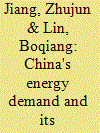|
|
|
Sort Order |
|
|
|
Items / Page
|
|
|
|
|
|
|
| Srl | Item |
| 1 |
ID:
124444


|
|
|
|
|
| Publication |
2013.
|
| Summary/Abstract |
Zhang and Qin (2013) argued that in Jiang and Lin (2012), the equation form and variable selection should be altered, and it was problematic to use regression equation to project the future. In this reply, we disagree with and will refute some of the points raised in their comments. The model that we established was based on the mature economic theory; with the variable selections all having economic implications. Considering the economic development stage, China's urbanization will speed up and this will have significant effect on energy consumption. Therefore, urbanization is an indispensable variable for analyzing energy demand in China. The scenario design only in terms of the GDP is sufficient for illustrating energy demand trend in China to be understood in a way by most of the people. Although energy forecast is not that precise, it has an important implication for energy policy design, especially for China which is in transition. And China's energy demand will keep high growth in the mid-term.
|
|
|
|
|
|
|
|
|
|
|
|
|
|
|
|
| 2 |
ID:
116984


|
|
|
|
|
| Publication |
2012.
|
| Summary/Abstract |
This paper is focused on the renewable energy targets set by China in its 12th National Development Plan 2011-2015. In particular, the paper examines deployment targets and the means to achieve them, for hydro, wind and solar. These are its priority technologies, in which the country has a level of competitive advantage. For each of these energy sources, four projections have been produced. These projections show whether and when China will meet its deployment targets in terms of the cumulative amount of gigawatts (GW) of installed capacity by 2015. In doing this, historical data from 2005 to 2010 has been analyzed for all three energy sources. Both the average annual growth rate (AAGR), and the compound average growth rate (CAGR) have been computed, in terms of the world averages and China's national performance over this period. AAGR and CAGR have been used for producing four scenarios for each renewable energy, and a logarithmic scale has been applied to them in order to make them more reliable by smoothing out excessive fluctuations. The most likely scenarios for each technology are described. Finally, the gap between these scenarios and the respective national targets set for 2015 and 2020 are calculated.
|
|
|
|
|
|
|
|
|
|
|
|
|
|
|
|
| 3 |
ID:
110354


|
|
|
|
|
| Publication |
2011.
|
| Summary/Abstract |
The long-term forecasting of energy supply and demand is an extremely important topic of fundamental research in Taiwan due to Taiwan's lack of natural resources, dependence on energy imports, and the nation's pursuit of sustainable development. In this article, we provide an overview of energy supply and demand in Taiwan, and a summary of the historical evolution and current status of its energy policies, as background to a description of the preparation and application of a Long-range Energy Alternatives Planning System (LEAP) model of Taiwan's energy sector. The Taiwan LEAP model is used to compare future energy demand and supply patterns, as well as greenhouse gas emissions, for several alternative scenarios of energy policy and energy sector evolution. Results of scenarios featuring "business-as-usual" policies, aggressive energy-efficiency improvement policies, and on-schedule retirement of Taiwan's three existing nuclear plants are provided and compared, along with sensitivity cases exploring the impacts of lower economic growth assumptions. A concluding section provides an interpretation of the implications of model results for future energy and climate policies in Taiwan.
|
|
|
|
|
|
|
|
|
|
|
|
|
|
|
|
|
|
|
|
|